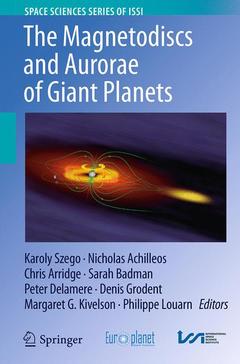Description
The Magnetodiscs and Aurorae of Giant Planets, Softcover reprint of the original 1st ed. 2016
Space Sciences Series of ISSI Series, Vol. 50
Coordinators: Szego Karoly, Achilleos Nicholas, Arridge Chris, Badman Sarah, Delamere Peter, Grodent Denis, Galland Kivelson Margaret, Louarn Philippe
Language: English
Subject for The Magnetodiscs and Aurorae of Giant Planets:
Keywords
Mass transport giant magnetodiscs; Magnetic reconnection; Solar wind interaction with Jupiter; Solar wind interaction with Saturn; Giant magnetospheres auroral physics; Satellite magnetosphere coupling; Kelvin-Helmholtz instability at magnetopause boundary; Magnetic flux circulation; Plasma injections in giant magnetodiscs; Ionospheric response to auroral forcing
Publication date: 08-2016
Support: Print on demand
Publication date: 10-2015
Support: Print on demand
Description
/li>Contents
/li>Biography
/li>Comment
/li>
Readers will find grouped together here the most recent observations, current theoretical models and present understanding of the coupled atmosphere, magnetosphere and solar wind system. The book begins with a general discussion of mass, energy and momentum transport in magnetodiscs. The physics of partially ionized plasmas of the giant planet magnetodiscs is of general interest throughout the field of space physics, heliophysics and astrophysical plasmas; therefore, understanding the basic physical processes associated with magnetodiscs has universal applications. The second chapter characterizes the solar wind interaction and auroral responses to solar wind driven dynamics. The third chapter describes the role of magnetic reconnection and the effects on plasma transport. Finally, the last chapter characterizes the spectral and spatial properties of auroral emissions, distinguishing between solar wind drivers and internal driving mechanisms. The in-depth reviews provide an excellent reference for future research in this discipline.
Giant Planet Magnetodiscs and Aurorae: An Introduction.- Planetary Magnetodiscs: Some Unanswered Questions.- A brief review of ultraviolet auroral emissions on giant planets.- Solar wind and internally driven dynamics: influences on magnetodiscs and auroral responses.- Auroral Processes at the Giant Planets: Energy Deposition, Emission Mechanisms, Morphology and Spectra.- Magnetic reconnection and associated transient phenomena within the magnetospheres of Jupiter and Saturn.- Transport of Mass, Momentum and Energy in Planetary Magnetodisc Regions.- Sources of local time asymmetries in magnetodiscs.
Dr. Nicholas Achilleos started his research career working in stellar astrophysics, in particular the magnetic field structures of white dwarf stars and their effects on radiative transfer, as well as the structure of the ‘halo’ region found in some accreting systems with magnetic white dwarfs. He then moved into planetary work, moving to UCL and working on a global, time-dependent circulation model of the Jovian thermosphere. A paper published using this model in 2001 was later awarded a ‘10th Anniversary Research Highlight’ of the New Journal of Physics. He then worked in industry as a software engineer for a short time before becoming a mission planner / support scientist for the Cassini magnetometer team in 2002. This allowed him to contribute to research which made use of the Cassini magnetic and other datasets. After moving to UCL to take up a lectureship in 2007, he worked with two UCL colleagues to produce a magnetodisc model of Saturn, adapted from Caudal’s original Jovian model, and the first two papers based on this model were published in 2010. This experience with magnetometer data and modelling of magnetodisc structure makes him a suitable editor for this particular volume.
Dr. Chris Arridge is a Royal Society Research Fellow and Lecturer in the Department of Physics at Lancaster University. He
These books may interest you

Auroral Physics 137.14 €



